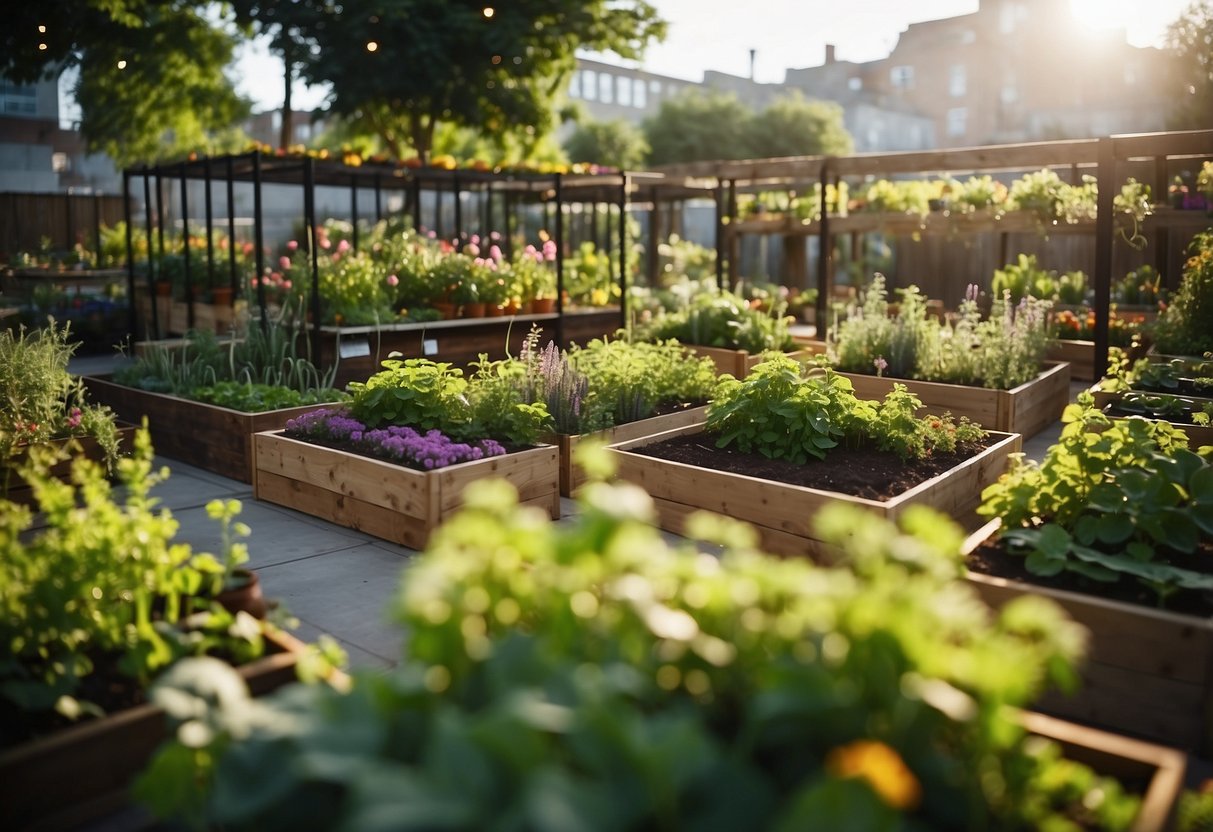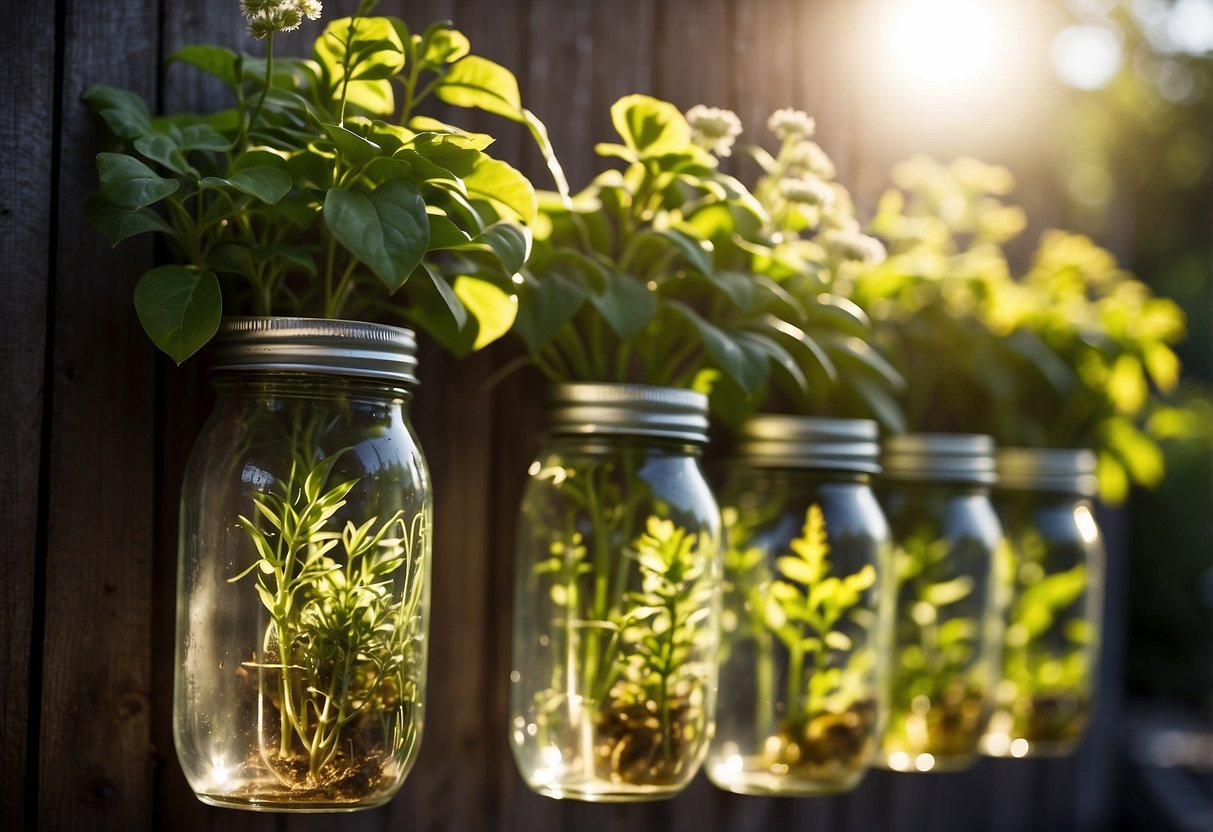Urban Garden Ideas: Simple Tips for a Greener City Life
Urban gardening opens up a world of possibilities for city dwellers who long to bring a touch of nature into their everyday lives. From tiny balconies to expansive rooftops, these green spaces can be tailored to fit any area. Urban gardening allows you to create a personal oasis right in the heart of the city.

Whether you’re interested in growing vegetables, herbs, flowers, or even a lush green lawn, urban gardening provides a creative and fulfilling way to utilize your outdoor space. You’ll find that it’s more than just a hobby; it’s a way to enhance your living environment and connect with nature.
1) Vertical Pallet Garden

Creating a vertical pallet garden is a great way to grow more plants in a small space. Start by finding a wooden pallet. Make sure it’s clean and not treated with harmful chemicals.
Lay the pallet flat. Attach landscape fabric to the back, bottom, and sides. This will hold the soil in place.
Fill the pallet with soil. Then, plant your favorite herbs, flowers, or vegetables. Once done, stand the pallet upright and make sure it’s stable.
Vertical pallet gardens are perfect for balconies or small patios. They add greenery without taking up much floor space.
2) Herb Spiral

An herb spiral is a great way to make the most of limited garden space. This spiral-shaped garden bed is taller in the middle and slopes down to the edges.
Herb spirals can be made from stones, bricks, or wood. The different levels provide various growing conditions for different herbs.
You can grow a variety of herbs like basil, thyme, and rosemary. These spirals are not only functional but also add a unique visual element to your garden.
For more detailed instructions, you can check how to build an herb spiral.
3) Recycled Container Planters

Recycled container planters are a great way to add charm to your urban garden. You can use items like egg cartons, old teapots, or cans. They’re fun to paint and decorate, too.
Try turning an old pallet into a vertical planter by painting it and propping it up. This can create extra space for growing vegetables or flowers.
Reusing everyday objects can make your garden unique and eco-friendly. It also helps reduce waste while giving your plants a home. Get creative with items you already have, and watch your urban garden bloom.
4) Windowsill Herb Garden

You can start a small herb garden right on your windowsill. It’s a perfect way to use limited space.
Make sure your herbs get plenty of sunlight. South- or east-facing windows are ideal.
Use quality potting soil and put saucers under the pots to avoid spills. Regularly prune and harvest your herbs to encourage growth and keep them healthy. Check out some creative ideas like a tiered tray garden or a floating shelf for more inspiration.
5) Hanging Shoe Organizer Garden

A hanging shoe organizer garden is a great way to grow plants in small spaces.
You can repurpose an old shoe organizer by hanging it on a wall, fence, or balcony.
Each pocket can hold herbs, small flowers, or leafy greens, allowing you to easily manage your urban garden.
Make sure it gets enough sunlight and water regularly. Use lightweight soil and remember to drill small holes for drainage.
This setup is budget-friendly and perfect for beginners looking to start an urban garden.
6) Tire Planters

Using old tires as planters is a fun and eco-friendly way to add some character to your urban garden. You can get creative with painted tire planters by choosing your favorite colors and designs.
A hanging tire planter is another great idea. Just paint, tie it securely to a rope, and hang it outside. For a unique touch, try a mosaic tire rim planter using paint to create beautiful designs.
7) Stacked Pot Herb Tower

A stacked pot herb tower is a great way to grow a variety of herbs in a small space. You can use different sizes of terracotta pots and stack them on top of each other.
To keep the structure stable, insert a metal or wooden rod through the center of the pots. Fill with soil and plant your favorite herbs.
You can place this tower in your balcony or patio. It’s both a space-saver and an eye-catching feature for your home.
8) Gutter Garden

A gutter garden is an
9) Mason Jar Wall Garden

Creating a Mason Jar Wall Garden is a great way to add green to your urban home. It’s stylish and space-efficient.
You’ll need mason jars, a wooden board, and hose clamps.
Clamp the jars onto the board, fill them with soil and your favorite herbs or succulents, and mount it on a sunny wall.
This setup not only saves space but also adds a charming touch to your decor. You can get creative by painting the jars or board to match your style.
This makes it perfect for small apartments or homes with limited outdoor space.
10) Ladder Plant Stand

A ladder plant stand is a great way to save space in your urban garden. These stands let you grow plants vertically, making the most of limited areas.
You can make one using old ladders or build your own. Check out these DIY ideas for inspiration.
Place your ladder plant stand near a sunny window or on a balcony. It adds a touch of green and can be a fun project to personalize your space.
Benefits of Urban Gardening

Urban gardening offers various significant advantages, from improving your health to positively impacting the environment.
Health Benefits
Engaging in urban gardening can improve both your physical and mental well-being. Being outdoors and working with soil can lower stress levels and enhance mood. Gardening also provides the physical exercise needed to keep your body active.
Additionally, growing your own fruits and vegetables means you have access to fresh, organic produce. This can lead to a healthier diet since you’re more likely to eat what you grow. Having your own garden also lets you control what goes into your food, ensuring it’s free from harmful chemicals.
Environmental Impact
Urban gardening helps the environment in multiple ways. By converting unused spaces into green areas, you help reduce urban heat islands. Plants cool the air around them, making your city more comfortable during hot weather.
Gardening also supports biodiversity. Your plants can provide habitats for pollinators like bees and butterflies. This can be especially crucial in urban areas where natural habitats are limited.
Furthermore, growing your own food reduces the need for transportation, lowering carbon emissions. This small step can contribute to a larger effort to combat climate change. By engaging in urban gardening, you become an active participant in creating a more sustainable environment.
Planning Your Urban Garden

Careful planning is crucial when starting an urban garden. Key factors include choosing the right space, selecting suitable plants, and ensuring good soil and containers.
Choosing The Right Space
Urban spaces can be small, so maximizing every inch is important. Look for areas like balconies, rooftops, or even windowsills. Ensure your chosen space gets at least 6 hours of sunlight a day. You can use mirrors to reflect light onto your plants, making your space feel larger and more vibrant. Vertical gardening, which involves growing plants on walls or in hanging pots, can also help you make the most of limited areas.
Selecting Appropriate Plants
Choose plants that thrive in urban environments. Herbs, leafy greens, and small vegetables like tomatoes or peppers are good options because they require less space and can often be grown in containers. Think about the climate and the amount of sunlight your space receives. Opt for plants that match these conditions. Additionally, consider the growth habit of plants. Dwarf or compact varieties are preferable, as they fit well into smaller spaces.
Soil And Containers
Good soil is essential for a thriving garden. Since urban areas may have poor natural soil, using potting mix is advisable. This mix is lightweight, drains well, and is enriched with nutrients. Containers should have drainage holes to prevent water from logging. You can choose from various containers like terracotta pots, plastic bins, or even fabric grow bags. Make sure the size of the container matches the growth requirement of your plants. Larger plants will need bigger containers to allow root expansion.
Maintenance Tips

Keeping your urban garden in top shape requires a few key techniques. Focus on smart watering, managing pests, and adjusting care with the seasons.
Watering Strategies
Proper watering is essential. Water in the morning to prevent evaporation and disease. Use drip irrigation or soaker hoses to deliver water directly to the roots, reducing waste.
For container plants, ensure pots have drainage holes to avoid root rot. Mulching helps retain soil moisture and reduce weed growth. Aim for a balance—soil should be moist, not soggy.
During hot spells, plants may need water daily, while cooler weather might only require weekly watering. Observe your plant’s needs and adjust as necessary.
Pest Control
Urban gardens face various pests like aphids, snails, and caterpillars. Hand-picking pests off plants is effective for small infestations. For larger issues, use natural repellents like neem oil or insecticidal soap.
Encourage beneficial insects such as ladybugs and praying mantises that prey on harmful pests. Planting companion plants like marigolds can deter certain pests.
Keep your garden clean. Remove fallen leaves and debris where pests might hide. Regular inspection helps catch problems early.
Seasonal Care
Adjusting your garden care with the seasons is crucial. In spring, fertilize your plants and begin planting new seeds or transplants. Summer calls for more frequent watering and weeding.
In fall, prune dead or overgrown branches and compost organic waste. This is also a good time to plant cover crops to enrich the soil. During winter, many plants go dormant. Protect them with mulch or row covers to insulate against frost.
By understanding and implementing these seasonal adjustments, you can keep your urban garden thriving year-round.







